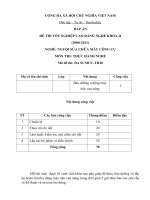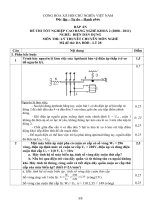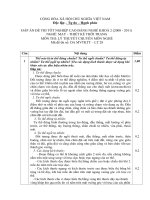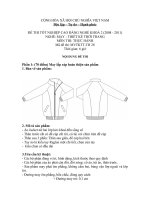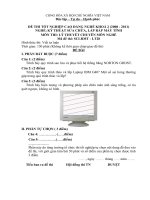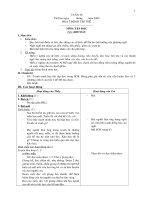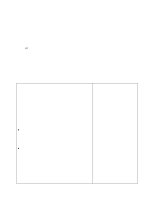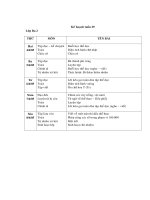PASSAGE 28
Bạn đang xem bản rút gọn của tài liệu. Xem và tải ngay bản đầy đủ của tài liệu tại đây (48.01 KB, 4 trang )
PASSAGE 28
China's massive urbanization in the past two decades has had a far-reaching impact on the practices of
visual arts. These repercussions are evident in agencies, subject matters, themes, styles of specific works,
art policies, spaces of production and dissemination, evaluation, art consumption and other areas. In
particular, the transformations of the urban space and the various phenomena and problems associated
with urbanization, such as construction boom, high mobility, technological innovation as well as
dislocation, social discrepancy and environmental deterioration, have been repeatedly addressed in visual
arts since the 1990s. The engagement of various stakeholders through visual arts have in turn also sparked
new interpretations of and visions for the city.
Artists have engaged in examining and envisioning new ways to understand the city in a great variety
of formats, such as photographs, installations, paintings, performances, multimedia art, documentaries,
films and urban art images (e.g. contemporary graffiti and street art). For example, Shanghai artist Ni
Weihua captures the penetration of consumerism through street billboards and contemplates the rising
social inequality along with the country's spectacular GDP-growth in his documentary photography
Landscape Wall; French street artist Julien Malland reveals the scars left to both Chinese urban fabric and
urbanites with his site-responsive works depicting ephemeral human figures.
Besides contemporary artists and filmmakers, average Chinese urbanites, local and international
corporations, non-profit organizations (NPOs) and government agencies are using visual arts for various
purposes. For example, growing pressure to urbanize and develop has strengthened the need for city
officials to employ visual arts for the improvement of living conditions and the construction of city image
through public art projects. Municipal officials in Beijing, Shanghai and Guangzhou, among others, have
also adopted new forms from electronic screens to contemporary graffiti to disseminate official messages
endorsing China's top-down and market-driven urban development.
Rapidly changing socio-spatial practices regarding the usage of urban public space are modifying
visual art in China. At the same time, new visual forms developed by artists and urbanites are not only
mirroring the transformations of Chinese cities but are actively reshaping the cityscapes through their
critical engagement with the urban space.
Question 1. What does the passage mainly discuss?
A. The massive urbanization in China in the past two decades.
B. The practices of visual arts in China.
C. Chinese visual arts in the age of urbanization.
D. Modern style of Chinese visual arts.
Question 2. All of the following are mentioned in the passage as an aspect of the visuals arts China 's
urbanization has had great influence on EXCEPT:
A. the ideas
B. the policies
C. the subjects
D. the viewers
Question 3. The phase "engage in" is closest in meaning to
A. be interested in
B. start
C. take part in
D. get down to
Question 4. The word "contemporary" in paragraph 2 is closet in meaning to________
A. short-lived
B. modern
C. ancient
D. artificial
Question 5. The author mentions Julien Malland as an example of
A. an artist whose works are inspired by urbanization in city
Page 1
B. an artist who is the first to try new forms of Chinese visual arts
C. an urbanite who is depicted in an artwork
D. an artist who experiences social inequality
Question 6. The words "others” in paragraph 3 refers to_________
A. public art projects
B. cities
C. municipal officials
D. new forms of arts
Question 7. According to paragraph, visual arts developed by artists and urbanites are used to
A. make a difference to the cityscapes
B. to inform people of official information
C. represent organizations and government agencies' images
D. boost the urbanization in China
Question 8. According to the passage, new visual arts in China__________.
A. are not popular with the urbanites
B. reflect the urbanization in cities
C. make no changes to the appearance of the cities
D. are used for only one purpose
ĐÁP ÁN
1-C
2-D
3-C
6-C
7-A
8-B
4-B
5-A
LỜI GIẢI CHI TIẾT
Question 1:
Đoạn văn chủ yếu thảo luận là gì?
A. Q trình đơ thị hóa khổng lồ ở Trung Quốc trong hai thập kỷ qua.
B. Các hoạt động nghệ thuật thị giác ở Trung Quốc.
C. Nghệ thuật thị giác của Trung Quốc trong thời đại đô thị hóa.
D. Phong cách hiện đại của nghệ thuật thị giác Trung Quốc.
=>Dẫn chứng: The engagement of various stakeholders through visual arts have in turn also sparked new
interpretations of and visions for the city.
Dịch: Sự tham gia của các bên liên quan khác nhau thông qua nghệ thuật thị giác đã lần lượt cũng gây ra
những giải thích và tầm nhìn mới cho thành phố.
Question 2:
Tất cả những điều sau đây được đề cập trong đoạn văn như một khía cạnh của nghệ thuật thị giác Sự đơ
thị hóa của Trung Quốc đã có ảnh hưởng lớn đến NGOẠI TRỪ:
A. các ý tưởng
B. các chính sách
C. các đối tượng
D. người xem
=> Dẫn chứng: These repercussions are evident in agencies, subject matters, themes, styles of specific
works, art policies, spaces of production and dissemination, evaluation, art consumption and other areas.
Dịch: Những hậu quả này thể hiện rõ trong các cơ quan, chủ đề, chủ đề, phong cách của các tác phẩm cụ
thể, chính sách nghệ thuật, không gian sản xuất và phổ biến, đánh giá, tiêu thụ nghệ thuật và các lĩnh vực
khác.
Page 2
Question 3:
Engage in (tham gia vào)= take part in
Be interested in: hứng thú đến
Start: bắt đầu
Get down to: nhận xuống
Question 4:
Từ "đương đại" trong đoạn 2 có nghĩa là _____
A. sống ngắn
B. hiện đại
C. cổ đại
D. nhân tạo
Question 5:
Tác giả đề cập Julien Malland là một ví dụ về
A. một nghệ sĩ có tác phẩm được truyền cảm hứng từ đơ thị hóa trong thành phố
B. một nghệ sĩ là người đầu tiên thử các hình thức mới của nghệ thuật thị giác Trung Quốc
C. một người thành thị được miêu tả trong một tác phẩm nghệ thuật
D. một nghệ sĩ trải nghiệm sự bất bình đẳng xã hội
=> Dẫn chứng: Artists have engaged in examining and envisioning new ways to understand the city in a
great variety of formats, such as photographs, installations, paintings, performances, multimedia art,
documentaries, films and urban art images
[...] French street artist Julien Malland reveals the scars left to both Chinese urban fabric and urbanites
with his site-responsive works depicting ephemeral human figures.
Dịch: Các nghệ sĩ đã tham gia vào việc kiểm tra và hình dung những cách mới để hiểu thành phố bằng
nhiều định dạng khác nhau, như ảnh, sắp đặt, tranh vẽ, biểu diễn, nghệ thuật đa phương tiện, phim tài liệu,
phim và hình ảnh nghệ thuật đô thị
[...] Nghệ sĩ đường phố người Pháp Julien Malland tiết lộ những vết sẹo để lại cho cả đô thị và đô thị
Trung Quốc với các tác phẩm phản ứng trên trang web của ông mô tả các hình người phù du.
Question 6:
Các từ "others” trong đoạn 3 đề cập đến ___
A. dự án nghệ thuật công cộng
B. thành phố
C. quan chức thành phố
D. các hình thức nghệ thuật mới
=> Dẫn chứng: Municipal officials in Beijing, Shanghai and Guangzhou, among others, have also
adopted new forms from electronic screens to contemporary graffiti to disseminate official messages
endorsing China's top-down and market-driven urban development.
Dịch: Các quan chức thành phố ở Bắc Kinh, Thượng Hải và Quảng Châu, trong số những người khác,
cũng đã áp dụng các hình thức mới từ màn hình điện tử đến graffiti hiện đại để phổ biến các thơng điệp
chính thức chứng thực sự phát triển đơ thị từ trên xuống và theo hướng thị trường.
Question 7:
Theo đoạn văn, nghệ thuật thị giác được phát triển bởi các nghệ sĩ và được người thành thị sử dụng để:
A. tạo sự khác biệt cho cảnh quan thành phố
B. để thơng báo cho mọi người thơng tin chính thức
C. đại diện cho hình ảnh của các tổ chức và cơ quan chính phủ
D. thúc đẩy q trình đơ thị hóa ở Trung Quốc
Page 3
=> Dẫn chứng: At the same time, new visual forms developed by artists and urbanites are not only
mirroring the transformations of Chinese cities but are actively reshaping the cityscapes through their
critical engagement with the urban space.
Dịch: Đồng thời, các hình thức trực quan mới được phát triển bởi các nghệ sĩ và người thành thị không
chỉ phản ánh sự biến đổi của các thành phố Trung Quốc mà cịn tích cực định hình lại cảnh quan thành
phố thơng qua sự tham gia quan trọng của họ với không gian đô thị.
Question 8:
Theo đoạn văn, nghệ thuật thị giác mới ở Trung Quốc.
A. không phổ biến với người thành thị
B. phản ánh q trình đơ thị hóa ở các thành phố
C. không làm thay đổi diện mạo của các thành phố
D. chỉ được sử dụng cho một mục đích
=> Dẫn chứng: Rapidly changing socio-spatial practices regarding the usage of urban public space are
modifying visual art in China
Dịch: Thay đổi nhanh chóng các thực tiễn không gian xã hội liên quan đến việc sử dụng không gian công
cộng đô thị đang sửa đổi nghệ thuật thị giác ở Trung Quốc
Page 4

